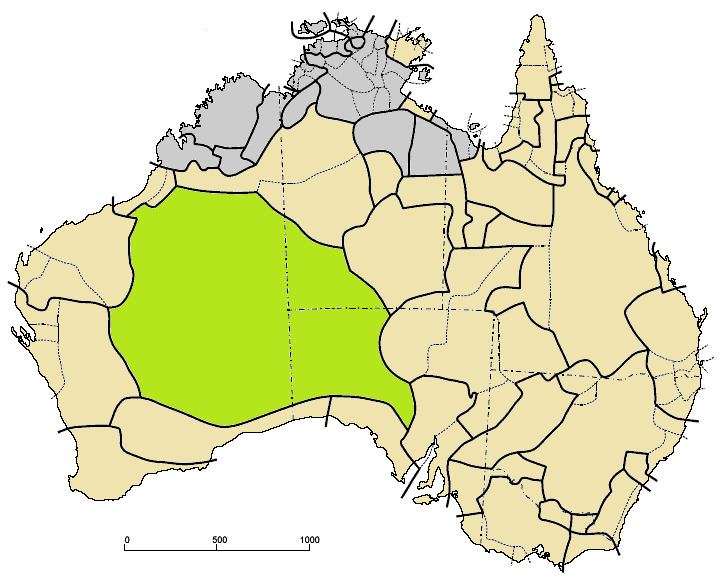Native speakers 7,400 (2006 census) | ||
 | ||
Language family Pama–NyunganWatiWestern Desert Dialects YulparijaManjtjiltjara (Martu Wangka)KartutjarraKukatjaPintupiLuritjaNgaatjatjarraNgaanyatjarraWangkathaWangkatja (Nyanganyatjara)Ngaliya (Ooldean)PitjantjatjaraYankunytjatjaraKukarta Signed forms Western Desert Sign LanguageManjiljarra Sign LanguageNgada Sign Language | ||
The Western Desert language, or Wati, is a dialect cluster of Australian Aboriginal languages in the Pama–Nyungan family.
Contents
- Location and list of communities
- Dialect continuum
- Dialects
- Status
- Phonology
- Vowels
- Consonants
- Orthography
- Sign language
- References
The name Wati tends to be used when considering the various varieties to be distinct languages, Western Desert when considering them dialects of a single language, or Wati as Wanman plus the Western Desert cluster.
Location and list of communities
The speakers of the various dialects of the Western Desert Language traditionally lived across much of the desert areas of Western Australia, South Australia and the Northern Territory. Most Western Desert people live in communities on or close to their traditional lands, although some now live in one of the towns fringing the desert area such as Kalgoorlie, Laverton, Alice Springs, Port Augusta, Meekatharra, Halls Creek and Fitzroy Crossing.
The following is a partial list of Western Desert communities:
Dialect continuum
The Western Desert Language consists of a network of closely related dialects; the names of some of these have become quite well known (such as Pitjantjatjara) and are often referred to as 'languages'. As the whole group of dialects that constitutes the language does not have its own name it is usually referred to as the Western Desert Language. WDL speakers referring to the overall language use various terms including wangka 'language' or wangka yuti 'clear speech'. For native speakers, the language is mutually intelligible across its entire range.
Dialects
Some of the named varieties of the Western Desert Language, with their approximate locations, are:
Starred names are listed as separate languages in Bowern (2011 [2012]).
Other names associated with Western Desert though they may not be distinct varieties include Dargudi (Targudi), Djalgandi (Djalgadjara), Kiyajarra (Giyadjara), Nakako, Nana (Nganawongka), Waljen, Wirdinya, and perhaps Mudalga.
Status
The Western Desert Language has thousands of speakers, making it one of the strongest indigenous Australian languages. The language is still being transmitted to children and has substantial amounts of literature, particularly in the Pitjantjatjara and Yankunytjatjara dialects in South Australia where there was formerly a long-running bilingual program.
Phonology
In the following tables of the WDL sound system, symbols in boldface give a typical practical orthography used by many WDL communities. Further details of orthographies in use in different areas are given below. Phonetic values in IPA are shown in [square brackets].
Vowels
The Western Desert Language has the common (for Australia) three-vowel system with a length distinction creating a total of six possible vowels.
Consonants
As shown in the chart, the WDL distinguishes five positions of articulation, and has oral and nasal occlusives at each position. The stops have no phonemic voice distinction but display voiced and unvoiced allophones; stops are usually unvoiced at the beginning of a word, and voiced elsewhere. In both positions, they are usually unaspirated. There are no fricative consonants.
Orthography
While the dialects of the WDL have very similar phonologies there are several different orthographies in use, resulting from the preferences of the different early researchers as well as the fact that the WDL region extends into three states (Western Australia, South Australia and the Northern Territory), with each having its own history of language research and educational policy.
Sign language
Most of the peoples of central Australia have (or at one point had) signed forms of their languages. Among the Western Desert peoples, sign language has been reported specifically for Kardutjara and Yurira Watjalku, Ngaatjatjarra (Ngada), and Manjiljarra. Signed Kardutjara and Yurira Watjalku are known to have been well-developed, though it is not clear from records that signed Ngada and Manjiljarra were.
